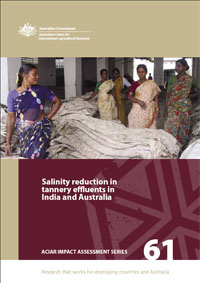- HomeHome
-
About ACIAR
- Our work
- Our people
-
Corporate information
- ACIAR Audit Committee
- Commission for International Agricultural Research
- Policy Advisory Council
- Agency reviews
- Executive remuneration disclosure
- Freedom of information (FOI)
- Gifts and benefits register
- Information publication scheme
- List of new agency files
- Contracts
- Legal services expenditure
- Privacy impact assessment register
- Commonwealth Child Safe Framework
- Benefits to Australia
- Careers
- 40 years of ACIAR
-
What we do
- Programs
- Cross-cutting areas
- Resources
- Where we work
-
Funding
- Research projects
- Fellowships
-
Scholarships
- John Allwright FellowshipScholarships to study in Australia for ACIAR partner country scientists to have Australian postgraduate qualifications
- ACIAR Pacific Agriculture Scholarships and Support and Climate Resilience Program
- Alumni Research Support Facility
- Publications
- News and Outreach
Impact assessment
Salinity reduction in tannery effluents in India and Australia
Date released
02 August 2009
Publication Code
IAS061
Overview
This study examines research undertaken in India, where communities are suffering economically and socially from the salt pollution from tanneries. Tannery wastes with high levels of salt and other dissolved solids have led to high levels of pollution in groundwater and rivers in both India and Australia. Several tanneries in India have been closed due to pollution. This study found that the project had developed technologies that lower the salinity of tannery effluent by reducing the quantity of salt used for skin and hide preservation, and by recycling various liquors used in the tanning process. The estimated net benefits to Indian tanneries is A$47.3 million in present-value terms (using a 5% discount rate), of which $22.4 million can be attributed to ACIAR on a cost-share basis. They represent an impressive 32.4% internal rate of return. Although acknowledging that these benefits hinge on uptake of the research, there are likely to be many converts once players in the industry realise the rewards of investing in the new technologies. Adoption by just 10–20% of the tanneries across the country (mostly in Tamil Nadu) would be a resounding justification for the research investment.



